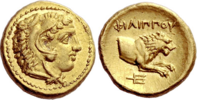The government of ancient Macedonia was first established sometime during the 8th–5th centuries BC. Little is known of its institutions before the reign of Philip II (depicted), from 359 to 336 BC. Administration evolved in complexity under his successor Alexander the Great and subsequent dynasties. It is unclear if a constitution was formally established. The king (basileus) served as the head of state, assisted by his noble companions and royal pages. Kings served as chief judges and high priests of the nation, using their wealth to sponsor religious cults and to fund the armed forces. They controlled the exploitation of gold and timber. The right to mint coins was shared by the central and some local governments. The kings were the commanders-in-chief of the armed forces and commonly led their troops into battle. The ancient Macedonian army held some of the functions of a popular assembly and had some authority over the royal succession. In 167 BC the Macedonian monarchy was abolished and replaced by four Roman client states. (Full article...)
